X-ray and Thermal Analysis of Selected Drugs Containing Acetaminophen
Abstract
:1. Introduction
1.1. X-ray Structural Analysis
1.2. Thermal Analysis
2. Results and Discussion
2.1. X-ray Phase Analysis
2.1.1. X-ray Characteristic of Pure ACP
2.1.2. X-ray Phase Analysis of Drugs Containing Only ACP
2.1.3. X-ray Phase Analysis of Drugs Containing ACP and Caffeine
2.1.4. X-ray Phase Analysis of Drugs Containing ACP, Caffeine and ASA
2.1.5. X-ray Phase Analysis of Drugs Containing ACP, Ascorbic Acid and Other APIs
2.1.6. X-ray Phase Analysis of Drugs Containing ACP and Other APIs
2.2. Thermal Analysis
2.2.1. DSC/TGA Measurements for Pure ACP and Drugs Containing Only ACP as API
2.2.2. DSC/TGA Measurements for Drugs Containing ACP and Caffeine
2.2.3. DSC/TGA Measurements of Drugs Containing ACP, Caffeine and ASA
2.2.4. DSC/TGA Measurements for Drugs Containing ACP and Other APIs
3. Materials and Methods
3.1. Materials
3.2. Methods
3.2.1. X-ray Analysis of Samples of Selected Drugs Containing ACP and Pure ACP
3.2.2. Thermal Analysis
4. Conclusions
Author Contributions
Funding
Conflicts of Interest
References
- Espeau, P.; Céolin, R.; Tamarit, J.-L.; Perrin, M.-A.; Gauchi, J.-P.; Leveiller, F. Polymorphism of paracetamol: Relative stabilities of the monoclinic and orthorhombic phases inferred from topological pressure-temperature and temperature-volume phase diagrams. J. Pharm. Sci. 2005, 94, 524–539. [Google Scholar] [CrossRef] [PubMed]
- Stanczyk, A.; Stanczyk, C. Polymorphism of pharmaceuticals. Drug Pol. 2013, 23, 50–58. (In Polish) [Google Scholar]
- World Health Organization. Counterfeit Medicines, Fact Sheet No. 275. Available online: https://www.gphf.org/images/downloads/library/who_factsheet275.pdf (accessed on 26 November 2020).
- World Health Organisation. Substandard and Falsified Medical Products. Available online: https://www.who.int/en/news-room/fact-sheets/detail/substandard-and-falsified-medical-products (accessed on 4 November 2020).
- France 24. French Customs Seize 1.2 Million Doses of Fake Aspirin. Available online: https://www.france24.com/en/20130526-french-customs-seize-biggest-haul-fake-medecine-ever-france-eu (accessed on 21 November 2020).
- Partnership for Safe Medicines. Fake Cancer Medicine Found to Only Contain Acetaminophen. Available online: https://www.safemedicines.org/2019/02/fake-cancer-medicine-found-to-only-contain-acetaminophen.html (accessed on 21 November 2020).
- Community Drug Strategy. Drug Alert: Health Canada Confirms Presence of Fentanyl/Acetaminophen in Pill-Shape Form. Available online: https://www.phsd.ca/drug-alert-health-canada-confirms-presence-of-fentanyl-acetaminophen-in-pill-shape-form (accessed on 21 November 2020).
- IP Twins. Counterfeit Paracetamol in the Philippines: What a Headache! Available online: https://www.iptwins.com/en/2018/04/13/counterfeit-paracetamol-in-the-philippines-what-a-headache (accessed on 21 November 2020).
- OECD. Trade in Counterfeit Pharmaceutical Products. Available online: https://www.oecd-ilibrary.org/sites/fe58fe07-en/index.html?itemId=/content/component/fe58fe07-en (accessed on 9 December 2020).
- Meyer, J.; Karst, U. Determination of paracetamol (acetaminophen) by HPLC with post-column enzymathic derivatization and fluorescence detection. Chrmatography 2001, 54, 163–167. [Google Scholar] [CrossRef]
- Attimarad, M. Simultaneous determination of paracetamol and lornoxicam by RP-HPLC in bulk and tablet formulation. Pharm. Methods 2011, 2, 61–66. [Google Scholar] [CrossRef] [PubMed] [Green Version]
- El-Gindy, A.; Attia, K.A.-S.; Nassar, M.W.; Abu Seada, H.H.; Al-Shabrawi Shoeib, M. HPLC method for determination of paracetamol, pseudoephedrine, triprolidine, methylparaben, propylparaben, sodium benzoate and their related substances in pharmaceutical syrup. J. Liq. Chrom. Relat. Technol. 2013, 36, 1251–1263. [Google Scholar] [CrossRef]
- Devi, T.A.P.; Setti, A.; Srikanth, S.; Nallapeta, S.; Pawar, S.C.; Rao, J.V. Method development and validation of paracetamol drug by RP-HPLC. J. Med. Allied Sci. 2013, 3, 8–14. [Google Scholar]
- Bojarski, Z.; Lągiewka, E. X-ray Structural Analysis; PWN: Warsaw, Poland, 1988. [Google Scholar]
- Dutrow, B.L.; Clark, C.M. X-ray Powder Diffraction (XRD), SERC. Available online: https://serc.carleton.edu/research_education/geochemsheets/techniques/XRD.html (accessed on 6 November 2020).
- Rendle, D.F. X-ray diffraction in forensic science. Rigaku J. 2003, 19, 11–22. [Google Scholar]
- Kugler, W. X-ray diffraction analysis in the forensic science: The last resort in many criminal cases. Adv. X-ray Anal. 2003, 46, 1–16. [Google Scholar]
- DeWitt, K.M. X-ray Powder Diffraction Method Development and Validation for the Identification of Counterfeit Pharmaceuticals; U.S. Food and Drug Administration: Cincinnati, OH, USA, 2015. Available online: https://www.marshall.edu/forensics/files/DeWitt-Kelsey-Research-Paper-08072015-Final.pdf (accessed on 13 December 2020).
- USP Pharmacopeial Convention. General. <941> Characterization of Crystalline and Partially Crystalline Solids by X-ray Powder Diffraction; The United States Pharmacopeial Convention: Rockville, MD, USA, 2011. [Google Scholar]
- Jendrzejewska, I. Application of X-ray powder diffraction for analysis of selected dietary supplements containing magnesium and calcium. Front. Chem. 2020, 8, 672. [Google Scholar] [CrossRef] [PubMed]
- Maurin, J.K.; Plucinski, F.; Mazurek, A.P.; Fijalek, Z. The usefulness of simple X-ray powder diffraction analysis for counterfeit control—The Viagra® example. J. Pharm. Biomed. Anal. 2007, 43, 1514–1518. [Google Scholar] [CrossRef] [PubMed]
- Sacchetti, M. Thermodynamic analysis of DSC data for acetaminophen polymorphs. J. Therm. Anal. Calorim. 2001, 63, 345–350. [Google Scholar] [CrossRef]
- Araújo, A.A.S.; dos Santos Bezerra, M.; Storpirits, S.; do Rosario Matos, J. Determination of the melting temperature, heat of fusion, and purity analysis of different samples of zidovudine (AZT) using DSC. Braz. J. Pharm. Sci. 2010, 46, 37–43. [Google Scholar] [CrossRef]
- The International Centre for Diffraction Data. PDF-2 Release; The International Centre for Diffraction Data: Newtown Township, PA, USA, 2008. [Google Scholar]
- Kachrimanis, K.; Braun, D.E.; Griesser, U.J. Quantitative analysis of paracetamol polymorphs in powder mixtures by FT–Raman spectroscopy and PLS regression. J. Pharm. Biomed. Anal. 2007, 43, 407–412. [Google Scholar] [CrossRef] [PubMed]
- Kaduk, J.A.; Zhong, K.; Gindhart, A.M.; Blanton, T.N. Crystal structure of tramadol hydrochloride, C16H26NO2Cl. Powder Diffr. 2015, 30, 242–249. [Google Scholar] [CrossRef]
- PubChem—National Center for Biotechnology Information. Acetaminophen. Available online: https://pubchem.ncbi.nlm.nih.gov/compound/acetaminophen (accessed on 21 November 2020).
- European Pharmacopoeia 7.0—Paracetamo. Available online: https://www.drugfuture.com/Pharmacopoeia/EP7/DATA/0049E.PDF (accessed on 21 November 2020).
- Nichols, G.; Frampton, C.F. Physicochemical characterization of the orthorhombic polymorph of paracetamol crystallized from solution. J. Pharm. Sci. 1998, 87, 684–693. [Google Scholar] [CrossRef] [PubMed]
- Klimová, K.; Leitner, J. DSC study and phase diagrams calculation of binary systems of paracetamol. Termochim. Acta 2012, 550, 59–64. [Google Scholar] [CrossRef]
- De Oliveira, G.G.G.; Feitosa, A.; Loureiro, K.; Fernandes, A.R.; Souto, E.B.; Severino, P. Compatibility study pf paracetamol, chlorpheniramine maleate and phenylephrine hydrochloride in physical mixtures. Saudi Pharm. J. 2017, 25, 99–103. [Google Scholar] [CrossRef] [PubMed] [Green Version]
- NIST WebBook Chemie, SRD 69. Acetaminophen. Available online: https://webbook.nist.gov/cgi/cbook.cgi?ID=C103902&Mask=4 (accessed on 27 November 2020).
- Crompton, T.R. Degree of crystallinity and melting temperature. In Practical Polymer Analysis; Springer: Boston, MA, USA, 1993. [Google Scholar]
- Giordano, F.; Rossi, A.; Bettini, R.; Savioli, A.; Gazzaniga, A.; Novak, C. Thermal behavior of paracetamol—Polymeric excipients mixtures. J. Therm. Anal. Calorim. 2002, 68, 575–590. [Google Scholar] [CrossRef]
- PubChem—National Center for Biotechnology Information. Caffeine. Available online: https://pubchem.ncbi.nlm.nih.gov/compound/caffeine (accessed on 28 November 2020).
- PubChem—National Center for Biotechnology Information. Aspirin. Available online: https://pubchem.ncbi.nlm.nih.gov/compound/aspirin (accessed on 28 November 2020).
- PubChem—National Center for Biotechnology Information. Ibuprofen. Available online: https://pubchem.ncbi.nlm.nih.gov/compound/Ibuprofen (accessed on 27 November 2020).
Sample Availability: Samples of the compounds are available from the authors. |
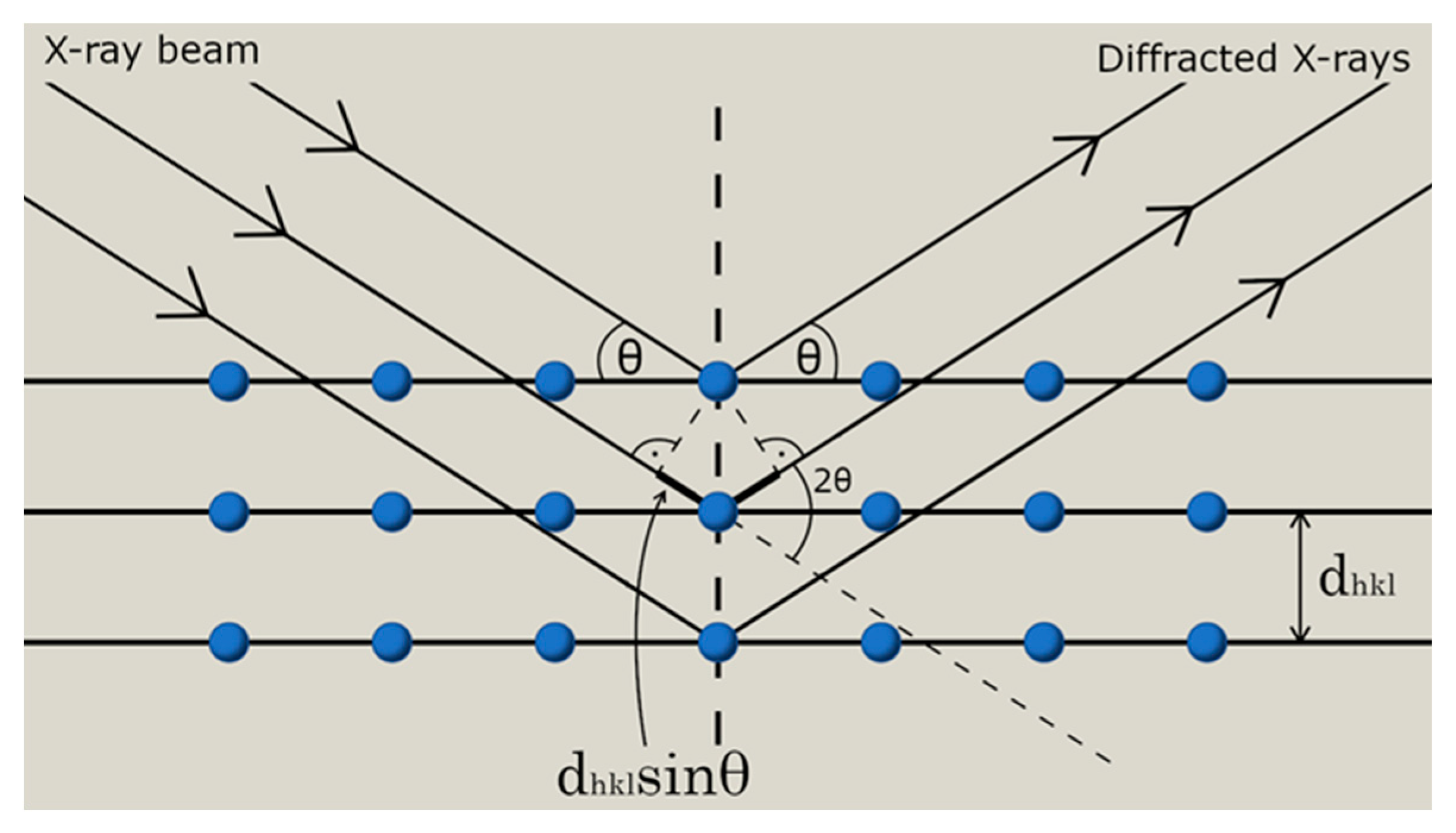
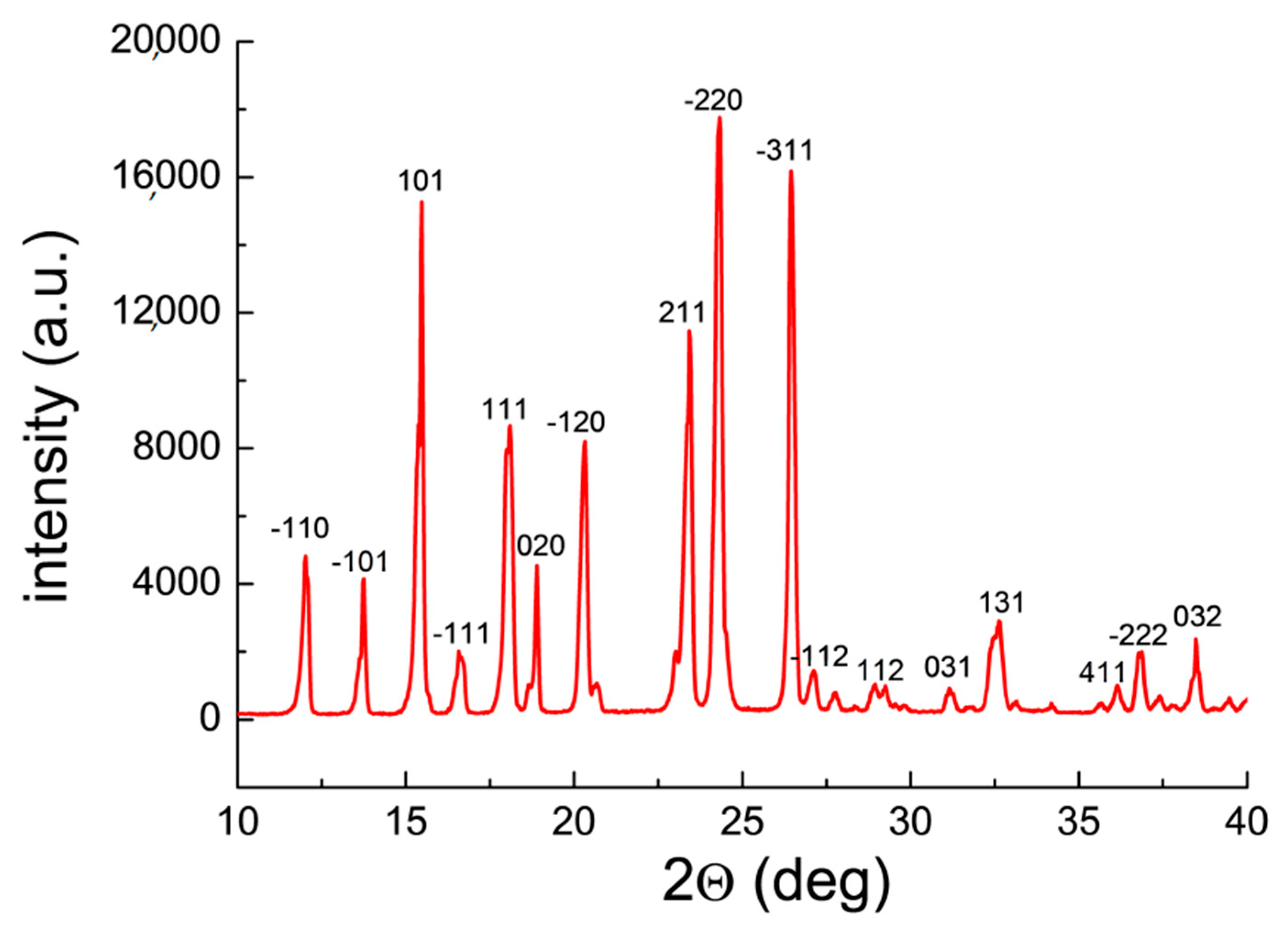
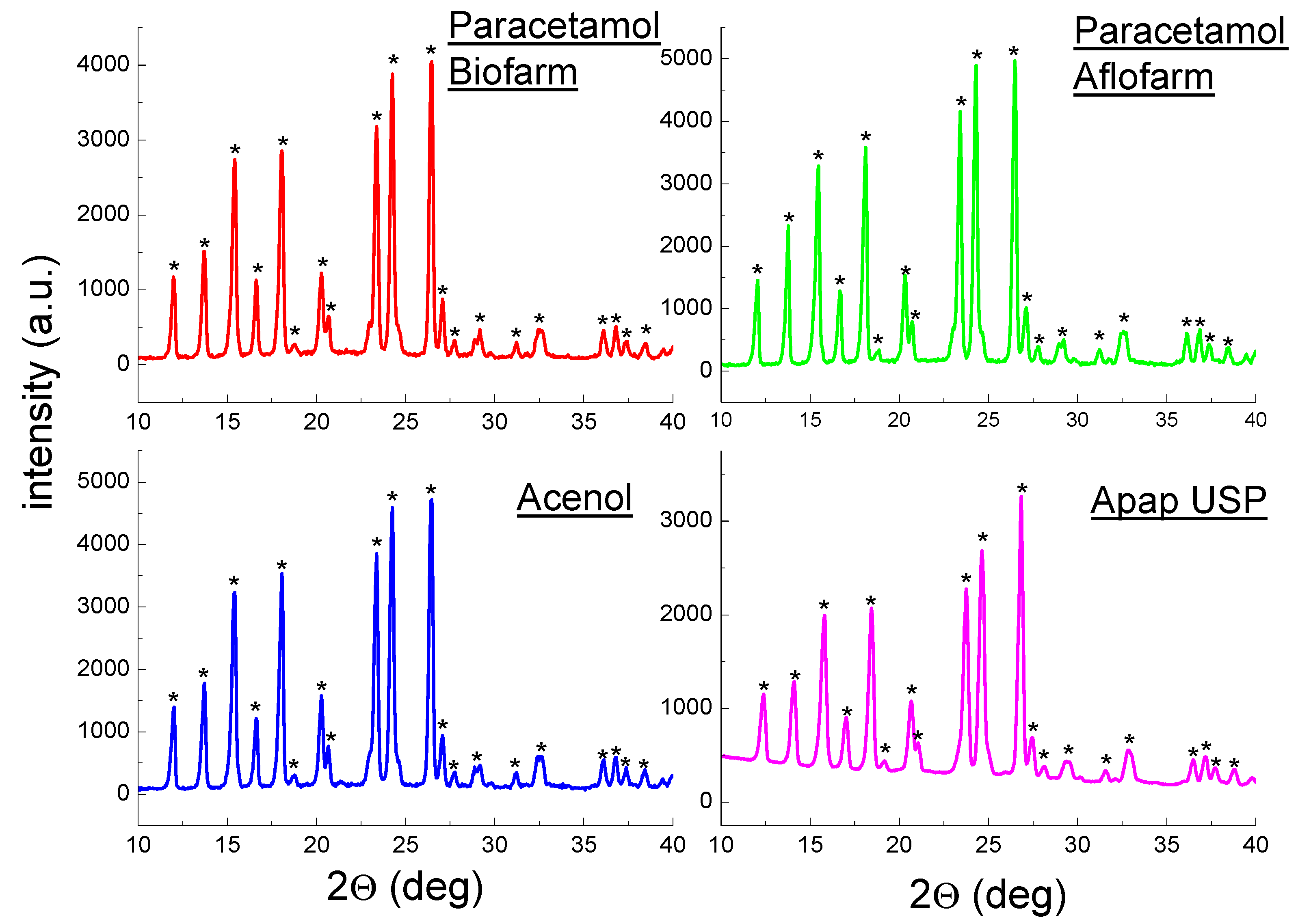
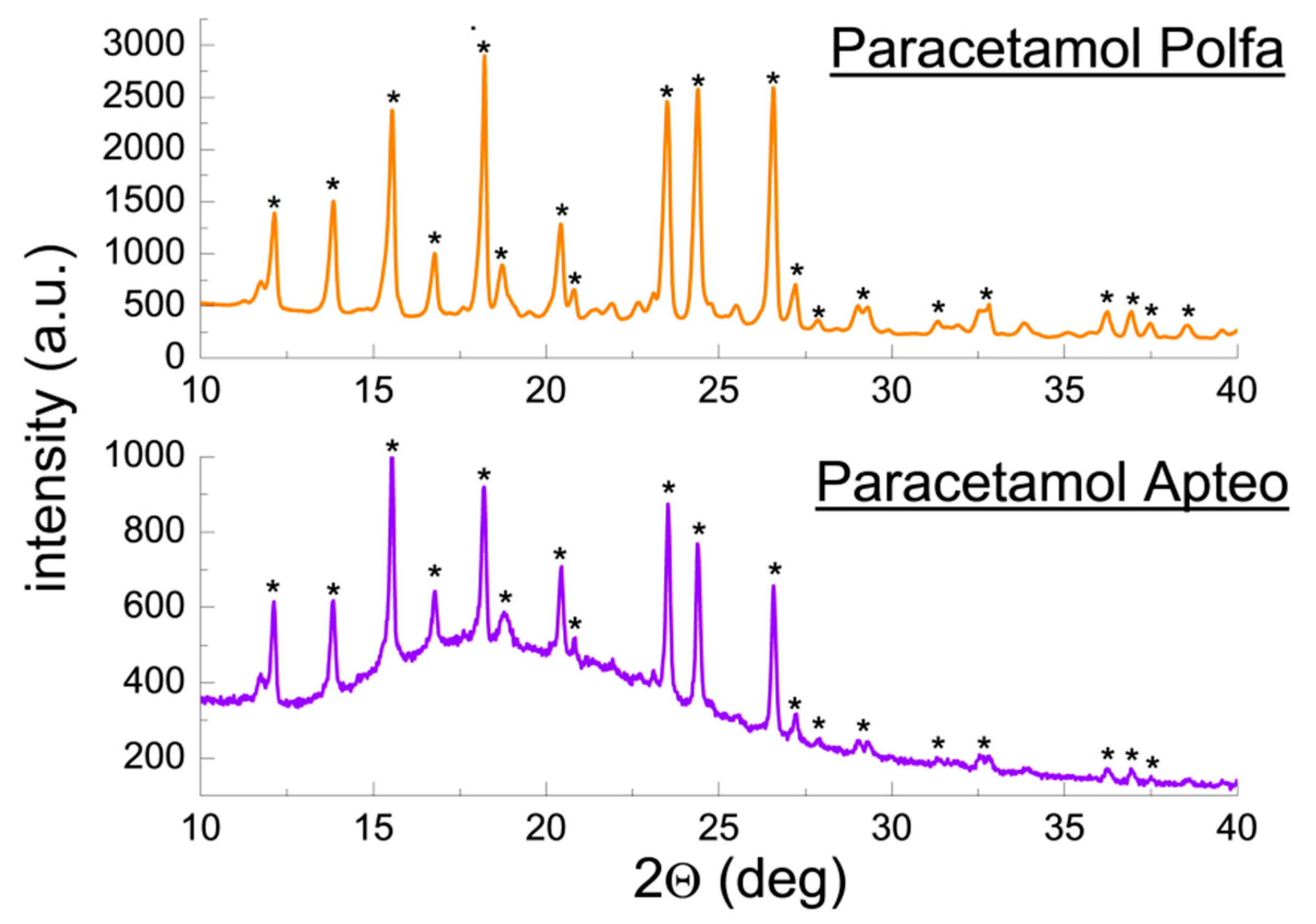
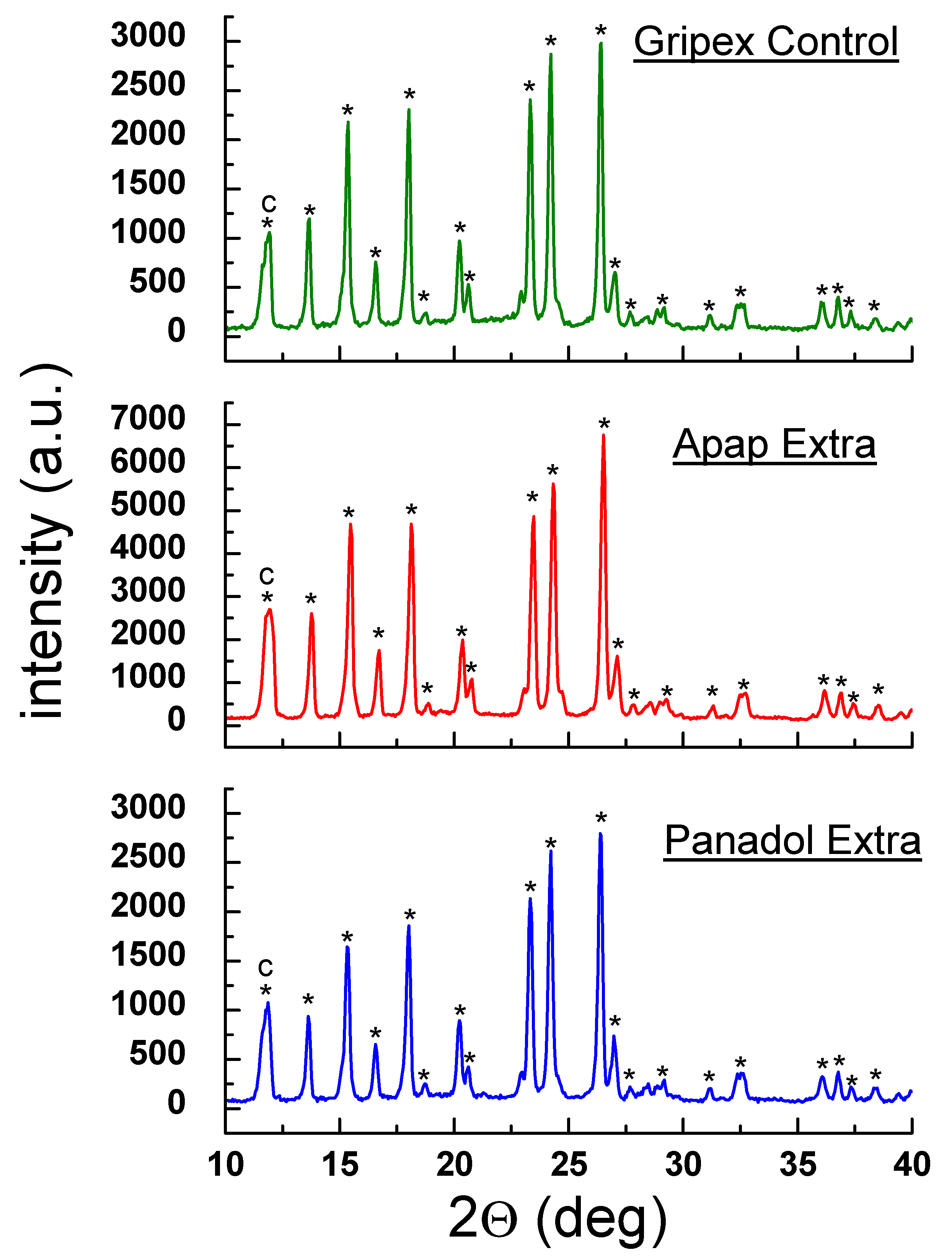
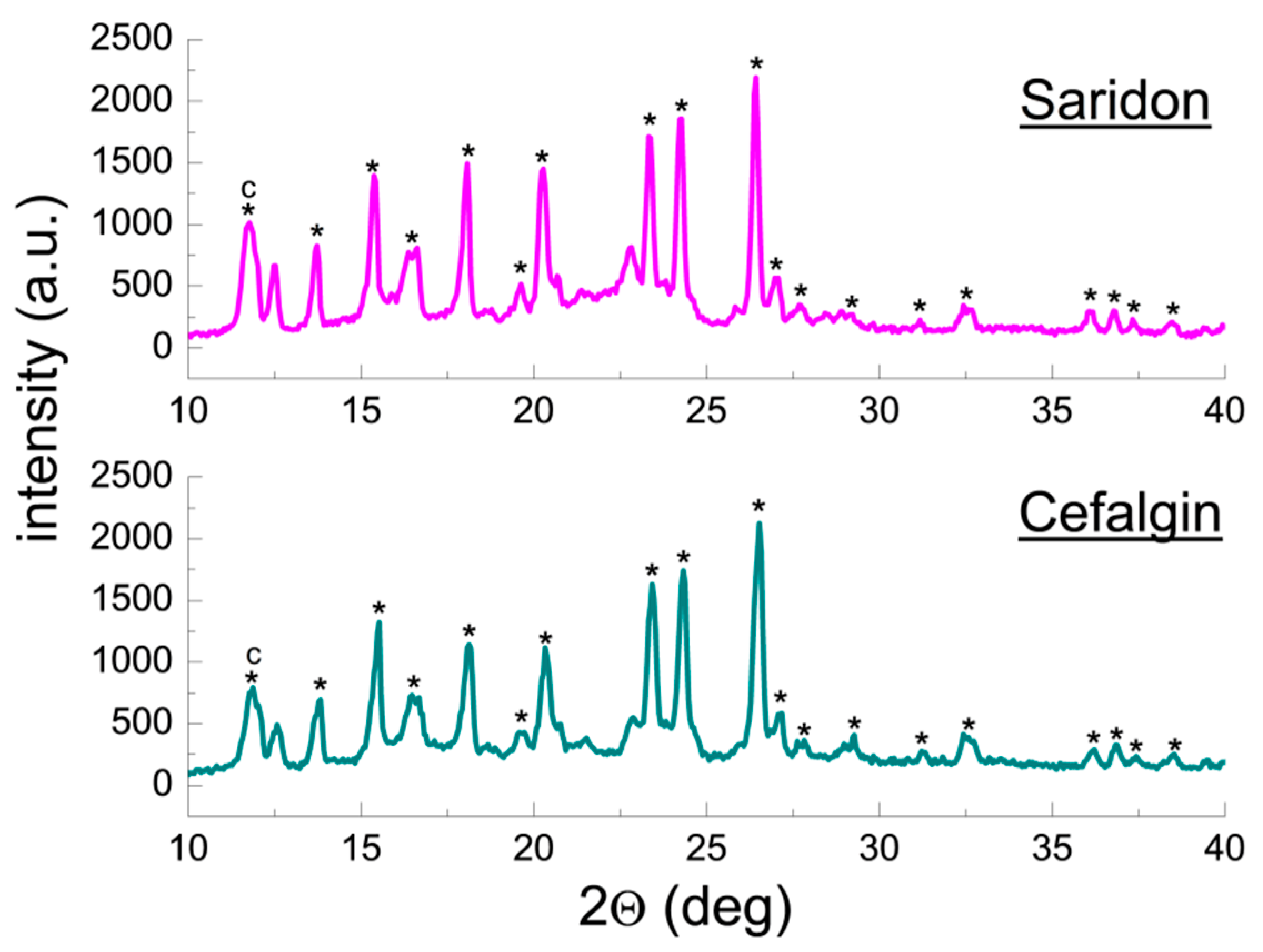
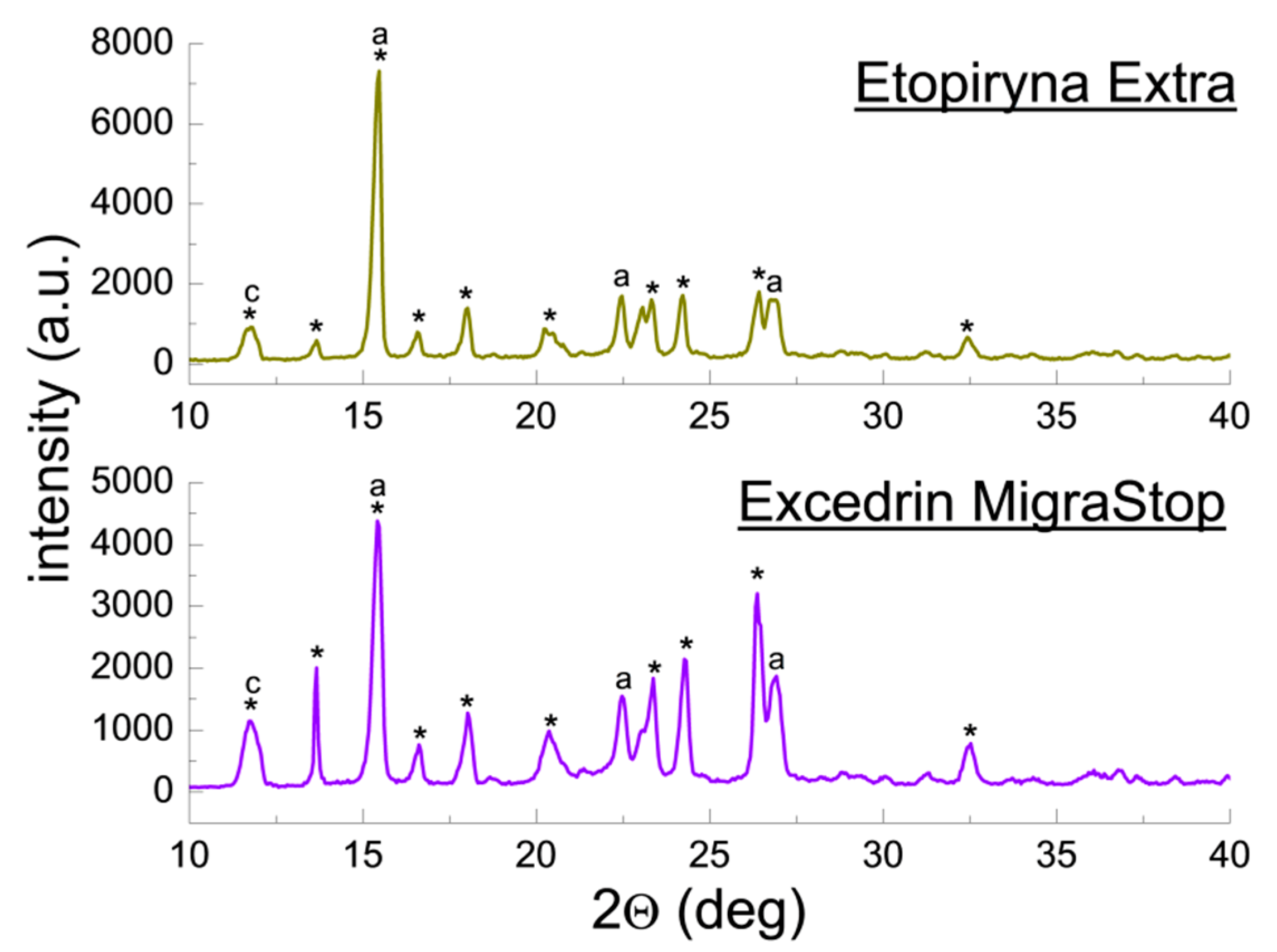
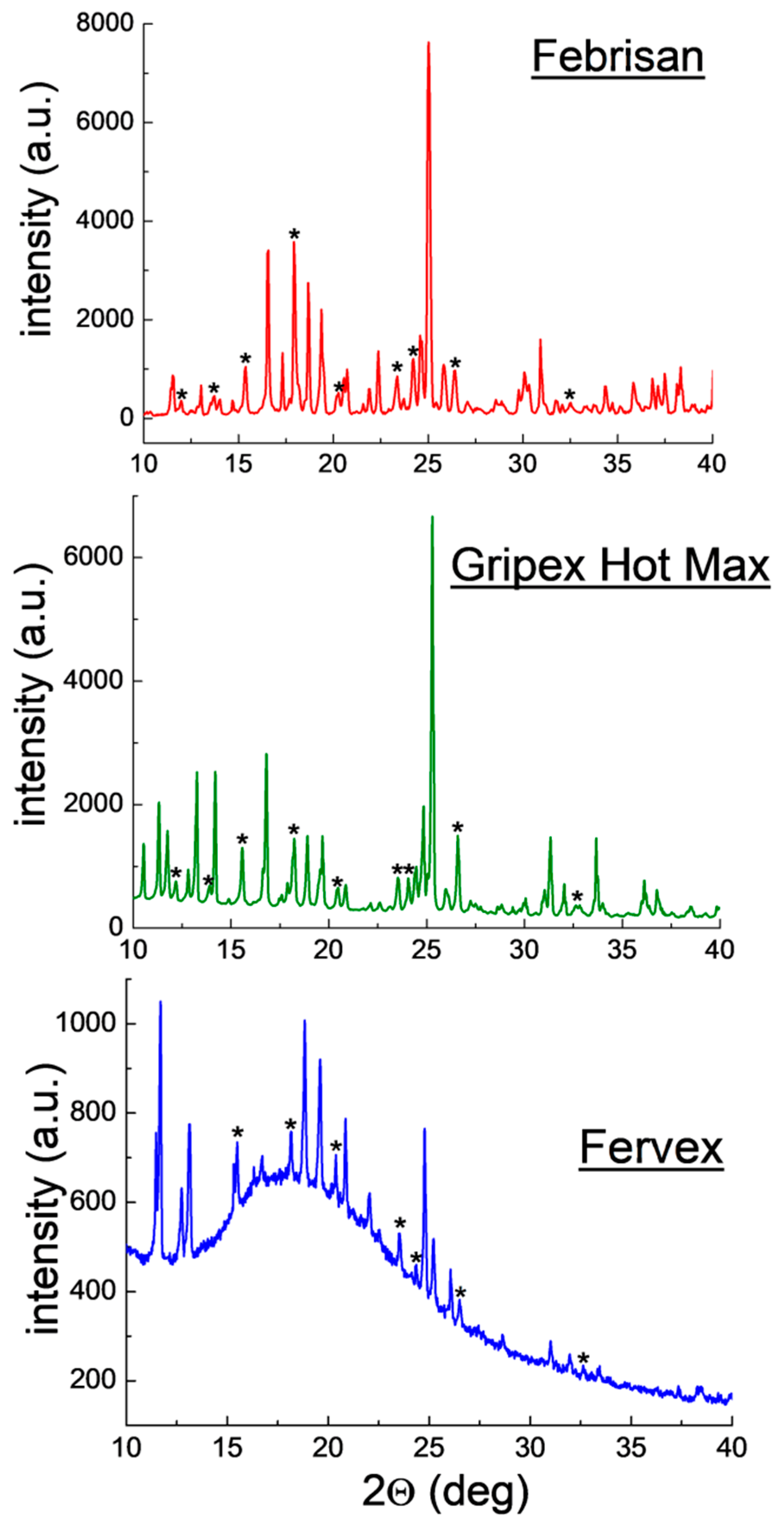
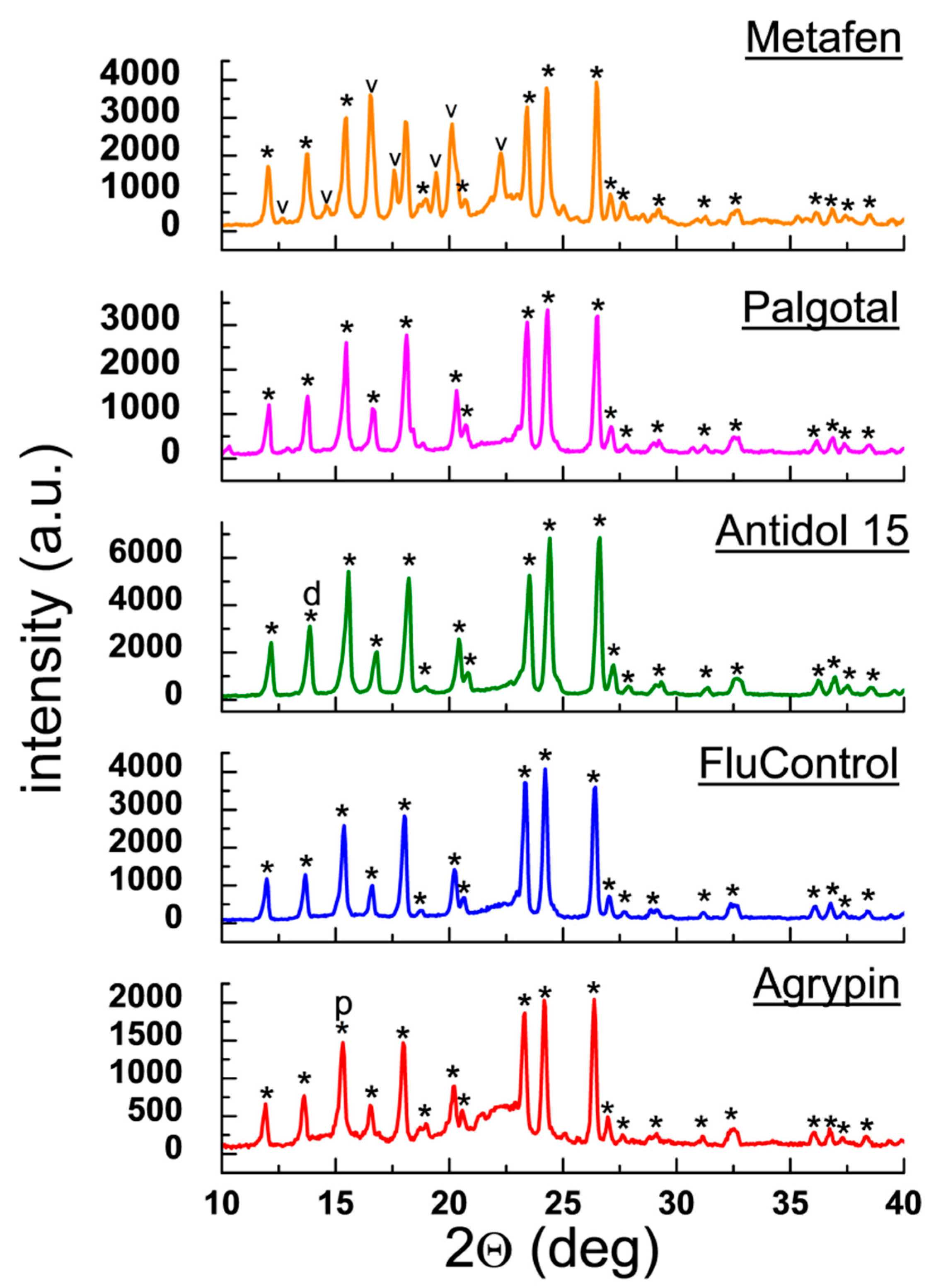

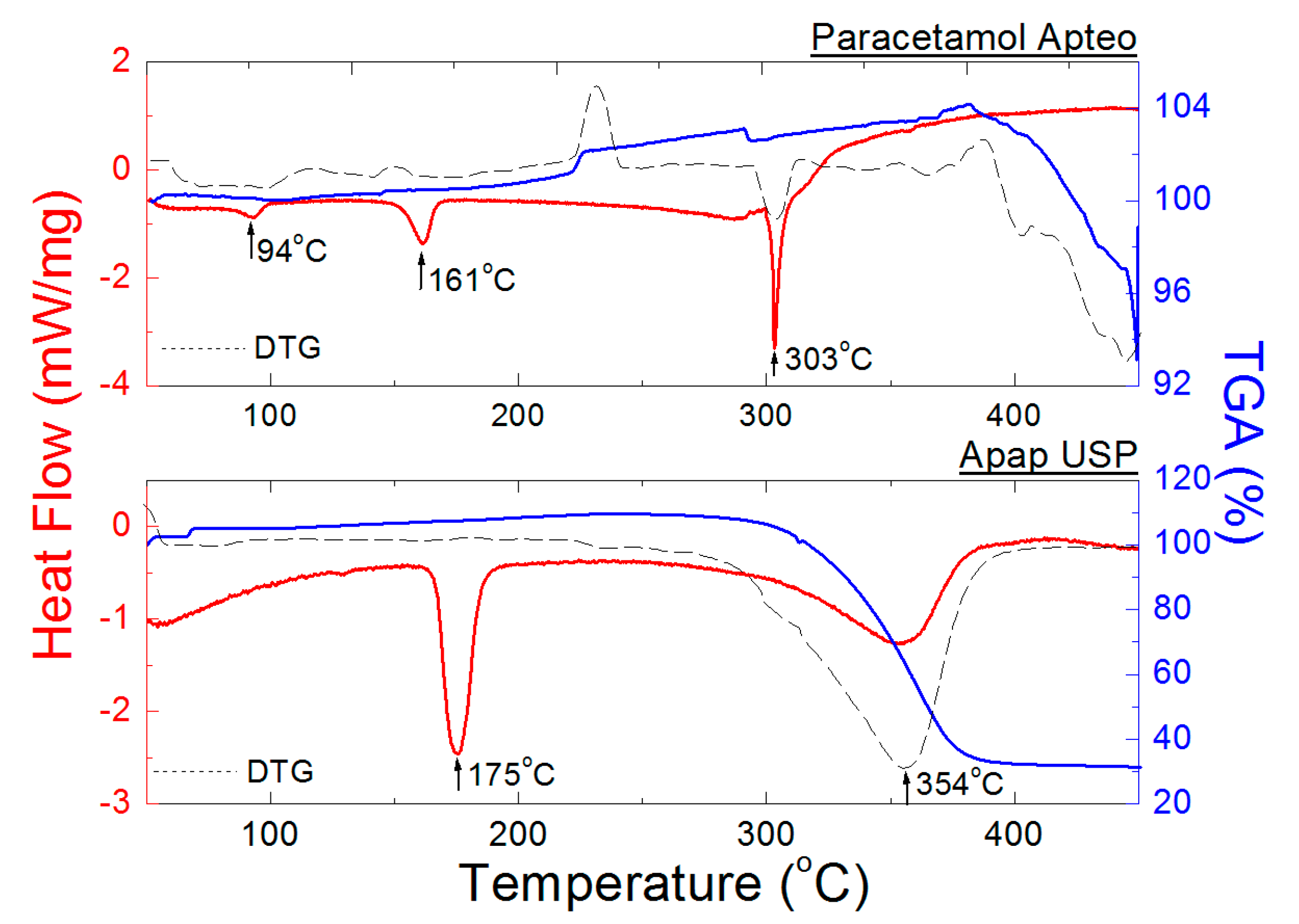
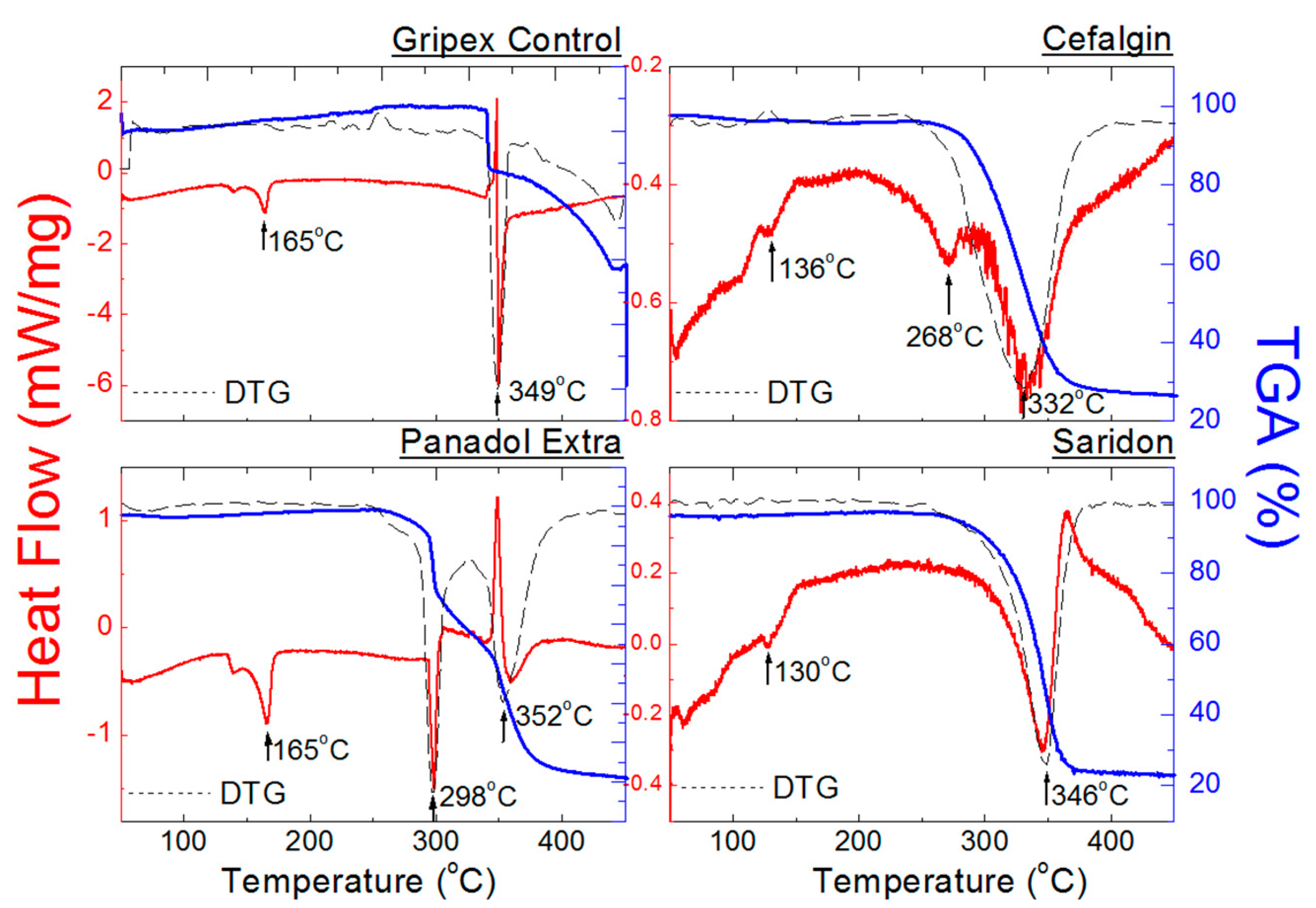
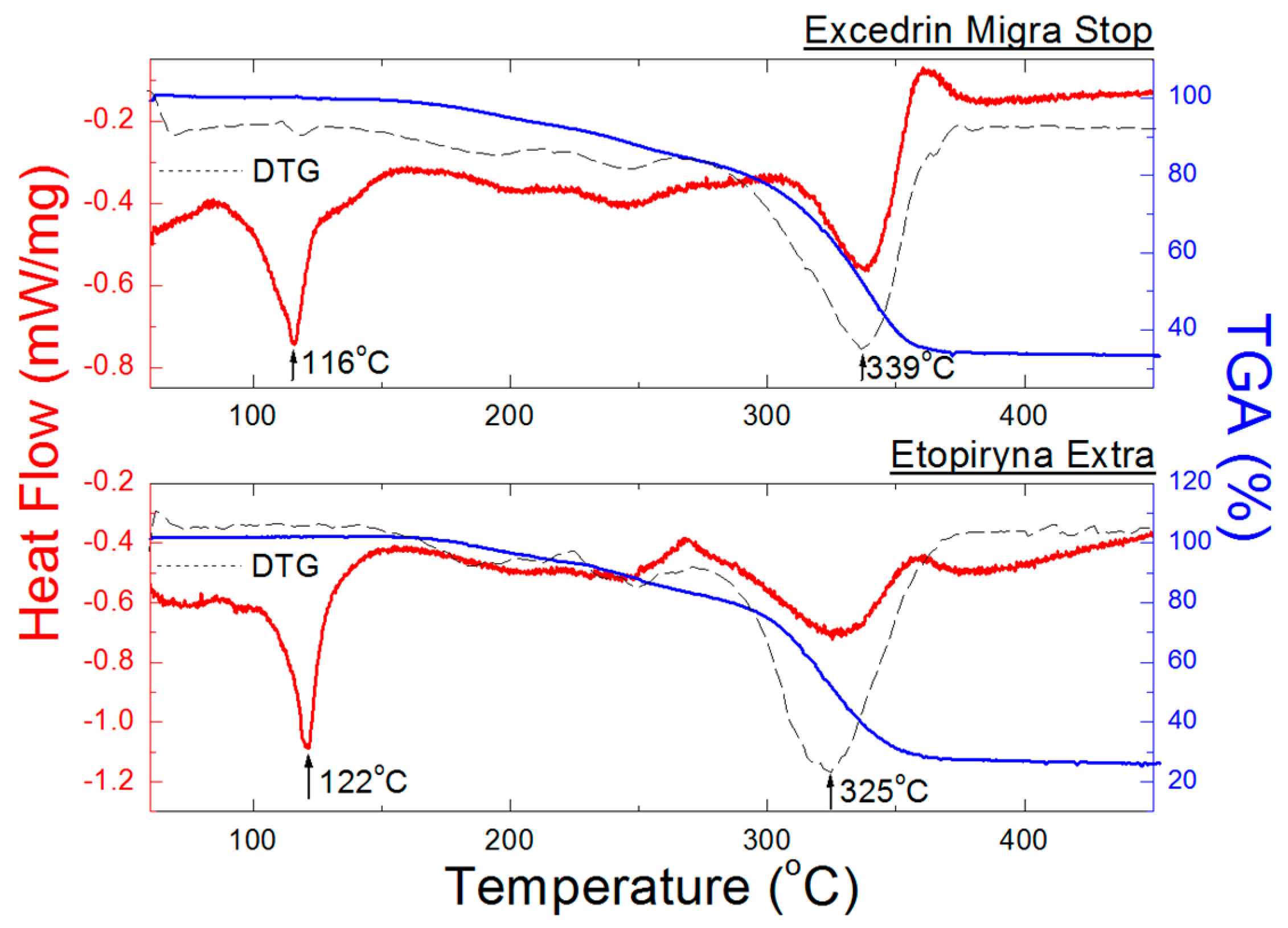
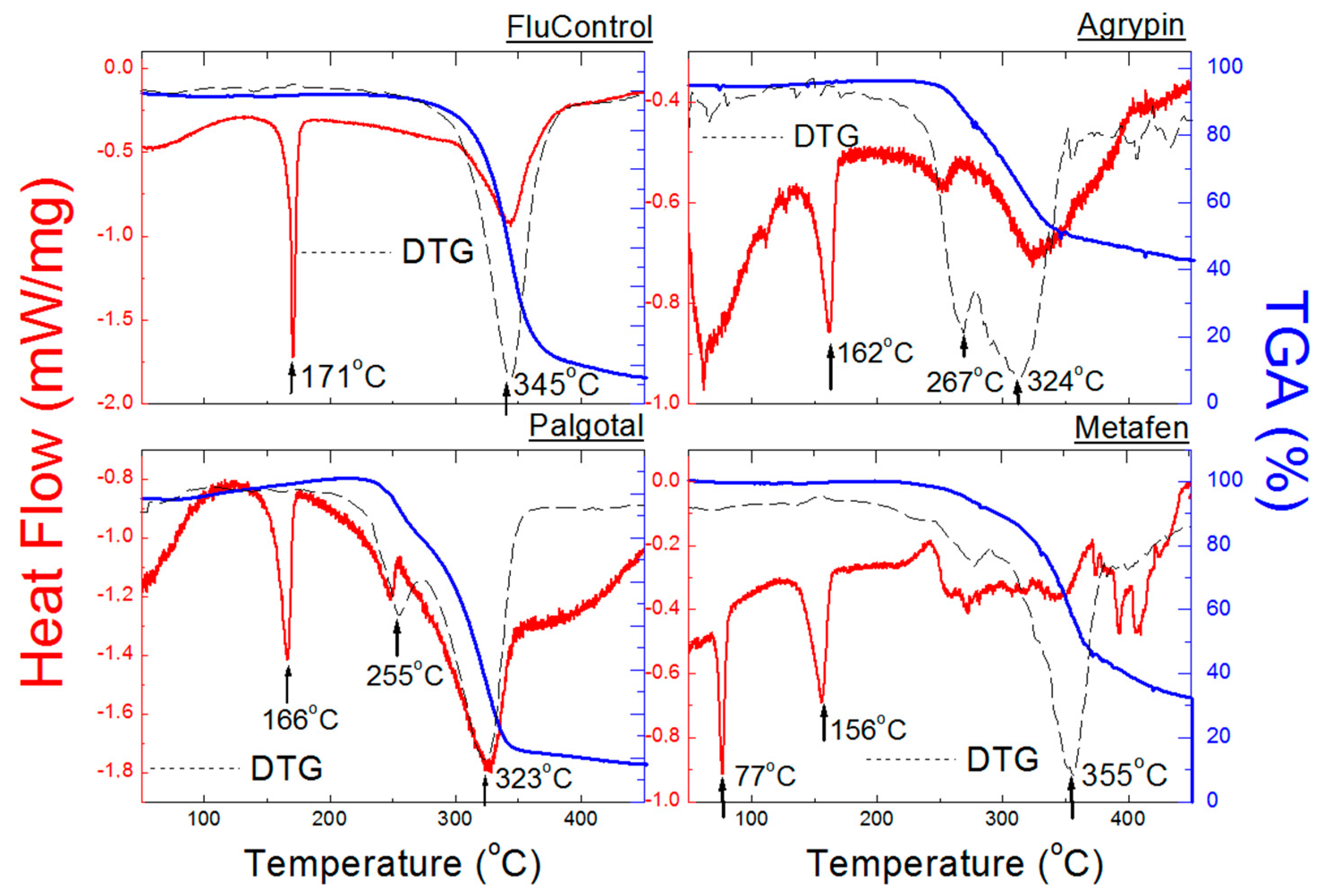
| No. of Diffraction Line | 2θ (°) Exp. | 2θ (°) ICDD | J/Jmax (%) Exp. | J/Jmax (%) ICDD | dhkl (Å) Exp. | dhkl (Å) ICDD | |
|---|---|---|---|---|---|---|---|
| Acetaminophen (C8H9NO2 PDF 00–039–1503) | |||||||
| 1 | 15.4853 | 15.5166 | 87 | 71 | 0.0313 | 5.7175 | 5.706 |
| 2 | 18.0840 | 18.1936 | 50 | 56 | 0.1096 | 4.9013 | 4.872 |
| 3 | 23.4478 | 23.4907 | 65 | 59 | 0.0429 | 3.7908 | 3.784 |
| 4 | 24.3119 | 24.3729 | 100 | 100 | 0.0610 | 3.6580 | 3.649 |
| 5 | 26.4561 | 26.5300 | 92 | 77 | 0.0739 | 3.3662 | 3.357 |
| No. of Diffraction Line | 2θ (°) Exp. | 2θ (°) ICDD | J/Jmax (%) Exp. | J/Jmax (%) ICDD | dhkl (Å) Exp. | dhkl (Å) ICDD | |
|---|---|---|---|---|---|---|---|
| Acetaminophen (C8H9NO2 PDF 00–054–2055) | |||||||
| Acenol | |||||||
| 1 | 26.4562 | 26.4258 | 100 | 100 | 0.0304 | 3.3662 | 3.37 |
| 2 | 24.2416 | 24.2313 | 98 | 80 | 0.0103 | 3.6685 | 3.67 |
| 3 | 23.3774 | 23.3904 | 83 | 66 | 0.0130 | 3.8021 | 3.80 |
| Apap USP | |||||||
| 1 | 26.4581 | 26.4258 | 100 | 100 | 0.0323 | 3.3660 | 3.37 |
| 2 | 24.2411 | 24.2313 | 84 | 80 | 0.0098 | 3.6685 | 3.67 |
| 3 | 23.3762 | 23.3904 | 72 | 66 | 0.0142 | 3.8023 | 3.80 |
| Paracetamol Biofarm | |||||||
| 1 | 26.4561 | 26.4258 | 100 | 100 | 0.0303 | 3.3662 | 3.37 |
| 2 | 24.2735 | 24.2313 | 95 | 80 | 0.0422 | 3.6637 | 3.67 |
| 3 | 23.3774 | 23.3904 | 78 | 66 | 0.0130 | 3.8021 | 3.80 |
| Paracetamol Aflofarm | |||||||
| 1 | 26.4906 | 26.4258 | 100 | 100 | 0.0648 | 3.3619 | 3.37 |
| 2 | 24.3326 | 24.2313 | 98 | 80 | 0.1013 | 3.6549 | 3.67 |
| 3 | 23.3971 | 23.3904 | 85 | 66 | 0.0067 | 3.7989 | 3.80 |
| No. of Diffraction Line | 2θ (°) Exp. | 2θ (°) ICDD | J/Jmax (%) Exp. | J/Jmax (%) ICDD | dhkl (Å) Exp. | dhkl (Å) ICDD | |
|---|---|---|---|---|---|---|---|
| Acetaminophen (C8H9NO2 PDF) | |||||||
| Paracetamol Polfa | |||||||
| 1 | 15.5471 | 15.4512 | 84 | 100 | 0.0959 | 5.6949 | 5.73 |
| 2 | 18.2247 | 18.1636 | 100 | 95 | 0.0611 | 4.8638 | 4.90 |
| 3 | 23.5099 | 23.3281 | 86 | 85 | 0.1818 | 3.7824 | 3.80 |
| Paracetamol Apteo | |||||||
| 1 | 15.5180 | 15.4512 | 100 | 100 | 0.0668 | 5.7055 | 5.73 |
| 2 | 18.1898 | 18.1636 | 94 | 95 | 0.0262 | 4.8730 | 4.90 |
| 3 | 23.5099 | 23.3281 | 89 | 85 | 0.1815 | 3.7824 | 3.80 |
| No. of Diffraction Line | 2θ (°) Exp. | 2θ (°) ICDD | J/Jmax (%) Exp. | J/Jmax (%) ICDD | dhkl (Å) Exp. | dhkl (Å) ICDD | |
|---|---|---|---|---|---|---|---|
| Gripex Control | |||||||
| Acetaminophen (C8H9NO2 PDF 00–054–2055) | |||||||
| 1 | 26.3955 | 26.4258 | 100 | 100 | 0.0303 | 3.3738 | 3.37 |
| 2 | 24.2077 | 24.2313 | 96 | 80 | 0.0236 | 3.6735 | 3.67 |
| 3 | 23.3163 | 23.3904 | 83 | 66 | 0.0768 | 3.8119 | 3.80 |
| Caffeine (C8H10N4O2 PDF 00–005–0149) | |||||||
| 1 | 11.8817 | 11.9174 | 37 | 100 | 0.0357 | 7.4422 | 7.42 |
| Apap Extra | |||||||
| Acetaminophen (C8H9NO2 PDF 00–054–2055) | |||||||
| 1 | 26.5306 | 26.4258 | 100 | 100 | 0.1048 | 3.3569 | 3.37 |
| 2 | 24.3473 | 24.2313 | 84 | 80 | 0.1160 | 3.6528 | 3.67 |
| 3 | 23.4514 | 23.3904 | 74 | 66 | 0.0610 | 3.7903 | 3.80 |
| Caffeine (C8H10N4O2 PDF 00–005–0149) | |||||||
| 1 | 11.8817 | 11.9174 | 43 | 100 | 0.0357 | 7.4422 | 7.42 |
| Panadol Extra | |||||||
| Acetaminophen (C8H9NO2 PDF 00–054–2055) | |||||||
| 1 | 26.3956 | 26.4258 | 100 | 100 | 0.0302 | 3.3738 | 3.37 |
| 2 | 24.2077 | 24.2313 | 96 | 80 | 0.0236 | 3.6735 | 3.67 |
| 3 | 23.3164 | 23.3904 | 80 | 66 | 0.0740 | 3.8119 | 3.80 |
| Caffeine (C8H10N4O2 PDF 00–005–0149) | |||||||
| 1 | 11.8187 | 11.9174 | 40 | 100 | 0.0987 | 7.4817 | 7.42 |
| Saridon | |||||||
| Acetaminophen (C8H9NO2 PDF 00–054–2055) | |||||||
| 1 | 26.4377 | 26.4258 | 100 | 100 | 0.0119 | 3.3685 | 3.37 |
| 2 | 24.2666 | 24.2313 | 86 | 80 | 0.0353 | 3.6647 | 3.67 |
| 3 | 23.3527 | 23.3904 | 79 | 66 | 0.0377 | 3.8060 | 3.80 |
| Caffeine (C8H10N4O2 PDF 00–005–0149) | |||||||
| 1. | 11.7695 | 11.9174 | 49 | 100 | 0.1479 | 7.5128 | 7.42 |
| Cefalgin | |||||||
| Acetaminophen (C8H9NO2 PDF 00–054–2055) | |||||||
| 1. | 26.5308 | 26.4258 | 100 | 100 | 0.1050 | 3.3570 | 3.37 |
| 2. | 24.3306 | 24.2313 | 84 | 80 | 0.0993 | 3.6552 | 3.67 |
| 3. | 23.4168 | 23.3904 | 79 | 66 | 0.0264 | 3.7958 | 3.80 |
| Caffeine (C8H10N4O2 PDF 00–005–0149) | |||||||
| 1. | 11.8335 | 11.9174 | 39 | 100 | 0.0839 | 7.4724 | 7.42 |
| No. of Diffraction Line | 2θ (°) Exp. | 2θ (°) ICDD | J/Jmax (%) Exp. | J/Jmax (%) ICDD | dhkl (Å) Exp. | dhkl (Å) ICDD | |
|---|---|---|---|---|---|---|---|
| Etopiryna Extra | |||||||
| Acetaminophen (C8H9NO2 PDF 00–027–1902) | |||||||
| 1 | 15.4831 | 15.4512 | 100 | 100 | 0.0319 | 5.7183 | 5.73 |
| 2 | 18.0326 | 18.1636 | 20 | 95 | 0.1310 | 4.9151 | 4.90 |
| 3 | 23.3876 | 23.3281 | 27 | 85 | 0.0595 | 3.8004 | 3.80 |
| Acetylsalicylic acid (C9H8O4 PDF 00–001–0182) | |||||||
| 1 | 15.4831 | 15.5331 | 100 | 100 | 0.0500 | 5.7183 | 5.70 |
| 2 | 26.8451 | 26.9968 | 25 | 40 | 0.1517 | 3.3183 | 3.30 |
| 3 | 22.4738 | 22.6647 | 27 | 32 | 0.1908 | 3.9529 | 3.92 |
| Caffeine (C8H10N4O2 PDF 00–005–0149) | |||||||
| 1 | 11.7695 | 11.9174 | 15 | 100 | 0.1479 | 7.5129 | 7.42 |
| Excedrin MigraStop | |||||||
| Acetaminophen (C8H9NO2 PDF 00–027–1902) | |||||||
| 1 | 15.4249 | 15.4512 | 100 | 100 | 0.0263 | 5.7397 | 5.73 |
| 2 | 18.0326 | 18.1636 | 33 | 95 | 0.1310 | 4.9151 | 4.90 |
| 3 | 23.3877 | 23.3281 | 45 | 85 | 0.0596 | 3.8004 | 3.80 |
| Acetylsalicylic acid (C9H8O4 PDF 00–001–0182) | |||||||
| 1 | 15.4249 | 15.5331 | 100 | 100 | 0.1082 | 5.7397 | 5.70 |
| 2 | 26.9092 | 26.9968 | 45 | 40 | 0.0876 | 3.3105 | 3.30 |
| 3 | 22.4738 | 22.6647 | 39 | 32 | 0.1908 | 3.9529 | 3.92 |
| Caffeine (C8H10N4O2 PDF 00–005–0149) | |||||||
| 1 | 11.7404 | 11.9174 | 30 | 100 | 0.1770 | 7.5314 | 7.42 |
| No. of Diffraction Line | 2θ (°) Exp. | 2θ (°) ICDD | J/Jmax (%) Exp. | J/Jmax (%) ICDD | dhkl (Å) Exp. | dhkl (Å) ICDD | |
|---|---|---|---|---|---|---|---|
| Acetaminophen (C8H9NO2 PDF 00–054–2055) | |||||||
| Febrisan | |||||||
| 1 | 26.4287 | 26.4258 | 17 | 100 | 0.0029 | 3.3696 | 3.37 |
| 2 | 24.1954 | 24.2313 | 20 | 80 | 0.0359 | 3.6754 | 3.67 |
| 3 | 23.3222 | 23.3904 | 15 | 66 | 0.0130 | 3.8110 | 3.80 |
| Acetaminophen (C8H9NO2 PDF 00–027–1902) | |||||||
| Gripex Hot Max | |||||||
| 1 | 15.5010 | 15.4512 | 21 | 100 | 0.0498 | 5.7117 | 5.73 |
| 2 | 18.1331 | 18.1636 | 23 | 95 | 0.0305 | 4.8881 | 4.90 |
| 3 | 23.4595 | 23.3281 | 14 | 85 | 0.1314 | 3.7890 | 3.80 |
| Fervex | |||||||
| 1 | 15.5147 | 15.4512 | 71 | 100 | 0.0635 | 5.7067 | 5.73 |
| 2 | 18.1930 | 18.1636 | 73 | 95 | 0.0294 | 4.8722 | 4.90 |
| 3 | 23.5241 | 23.3281 | 51 | 85 | 0.1960 | 3.7787 | 3.80 |
| No. | Product Name (Manufacturer) | ACP Content in 1 Tablet/Sachet [mg] | Selected Additional APIs |
|---|---|---|---|
| 1. | Acetaminophen (Sigma) | - | - |
| 2. | Apap (USP Zdrowie) | 500 | - |
| 3. | Paracetamol (Aflofarm) | 500 | - |
| 4. | Acenol (Galena) | 300 | - |
| 5. | Paracetamol (Biofarm) | 1000 | - |
| 6. | Paracetamol (Polfa Łódź) | 500 | - |
| 7. | Paracetamol Apteo (Synoptis Pharma) | 500 | - |
| 8. | Apap Extra (US Pharmacia) | 500 | Caffeine (65 mg) |
| 9. | Gripex Control (US Pharmacia) | 500 | Caffeine (50 mg) |
| 10. | Panadol Extra (GSK Consumer Healthcare) | 500 | Caffeine (65 mg) |
| 11. | Cefalgin (Adamed) | 250 | Caffeine (50 mg) |
| 12. | Saridon (Bayer) | 250 | Caffeine (50 mg) |
| 13. | Excedrin Migra Stop (GSK Consumer Healthcare) | 250 | Caffeine (65 mg) ASA (250 mg) |
| 14. | Etopiryna Extra (Polpharma) | 200 | Caffeine (50 mg) ASA (250 mg) |
| 15. | FluControl (Aflofarm) | 650 | Phenylephrine·HCl (10 mg) |
| 16. | Agrypin (Polfa Tarchomin) | 325 | Pseudoephedrine·HCl (30 mg) |
| 17. | Metafen (Polpharma) | 325 | Ibuprofen (200 mg) |
| 18. | Antidol 15 (Sandoz) | 500 | Codeine phosphate (15 mg) |
| 19. | Palgotal (Zentiva a Sanofi Company) | 650 | Tramadol·HCl (75 mg) |
| 20. | Febrisan (Takeda Pharma) | 750 | Phenylephrine·HCl (10 mg) Ascorbic acid (60 mg) |
| 21. | Gripex Hot Max (US Pharmacia) | 1000 | Phenylephrine·HCl (12.2 mg) Ascorbic acid (100 mg) |
| 22. | Fervex (Bristol Meyers Sqibb Poland) | 500 | Pheniramine maleate (25 mg) Ascorbic acid (200 mg) |
| No. of Diffraction Line | 2θ (°) Exp. | 2θ (°) ICDD | J/Jmax (%) Exp. | J/Jmax (%) ICDD | dhkl (Å) Exp. | dhkl (Å) ICDD | |
|---|---|---|---|---|---|---|---|
| Acetaminophen (C8H9NO2 PDF 00–054–2055) | |||||||
| Metafen | |||||||
| 1. | 26.4545 | 26.4258 | 100 | 100 | 0.0287 | 3.3664 | 3.37 |
| 2. | 24.2917 | 24.2313 | 96 | 80 | 0.0604 | 3.6610 | 3.67 |
| 3. | 23.4191 | 23.3904 | 84 | 66 | 0.0287 | 3.7954 | 3.80 |
| Ibuprofen (C13H18O2 PDF 00–030–1757) | |||||||
| 1. | 16.5495 | 16.4941 | 100 | 100 | 0.0554 | 5.3533 | 5.37 |
| 2. | 20.1826 | 20.1647 | 79 | 95 | 0.0179 | 4.3961 | 4.40 |
| 3. | 17.5587 | 17.5123 | 46 | 60 | 0.0464 | 5.0467 | 5.06 |
| Palgotal | |||||||
| 1. | 26.4545 | 26.4258 | 96 | 100 | 0.0287 | 3.3664 | 3.37 |
| 2. | 24.3676 | 24.2313 | 100 | 80 | 0.1363 | 3.6454 | 3.67 |
| 3. | 23.4191 | 23.3904 | 93 | 66 | 0.0287 | 3.7954 | 3.80 |
| Antidol 15 | |||||||
| 1. | 26.5836 | 26.4258 | 100 | 100 | 0.1578 | 3.3503 | 3.37 |
| 2. | 24.3678 | 24.2313 | 99 | 80 | 0.1365 | 3.6500 | 3.67 |
| 3. | 23.4823 | 23.3904 | 75 | 66 | 0.0919 | 3.7853 | 3.80 |
| Codeine phosphate (C36H48N2O14P2 PDF 00–51–1963) | |||||||
| 1. | 14.0459 | 13.9395 | 46 | 100 | 0.1064 | 6.3000 | 6.35 |
| FluControl | |||||||
| 1. | 26.4158 | 26.4258 | 88 | 100 | 0.0100 | 3.3712 | 3.37 |
| 2. | 24.2578 | 24.2313 | 100 | 80 | 0.0265 | 3.6660 | 3.67 |
| 3. | 23.3098 | 23.3904 | 91 | 66 | 0.0806 | 3.8130 | 3.80 |
| Agrypin | |||||||
| 1. | 26.3534 | 26.4258 | 100 | 100 | 0.0724 | 3.3791 | 3.37 |
| 2. | 24.1954 | 24.2313 | 98 | 80 | 0.0359 | 3.6754 | 3.67 |
| 3. | 23.3222 | 23.3904 | 91 | 66 | 0.0682 | 3.8110 | 3.80 |
| Pseudoephedrine hydrochloride (C10H15NO·HCl PDF 00–029–1885) | |||||||
| 1. | 15.3829 | 15.4512 | 71 | 100 | 0.0683 | 5.76 | 5.73 |
| Drug Name | Weight Loss (%) | Onset (°C) | Endset (°C) | Peak Maximum (°C) | Peak Height (mW) | Peak Area (J) | Enthalpy (J/g) |
|---|---|---|---|---|---|---|---|
| Acetaminophen | 76 | 169 321 | 175 378 | 172 364 | 31.9 10.9 | 1.715 4.654 | 171.5 465.4 |
| Apap USP | 77 | 167 238 | 184 373 | 175 354 | 11.4 5.66 | 0.859 1.830 | 143.2 305.2 |
| Paracetamol Aflofarm | 75 | 169 306 | 177 373 | 174 359 | 12.5 5.53 | 1.086 2.795 | 136.9 430.0 |
| Paracetamol Biofarm | 78 | 168 359 | 177 372 | 174 339 | 13.2 6.97 | 1.036 3.887 | 141.9 532.5 |
| Paracetamol Apteo | 74 | 92 155 302 | 96 167 306 | 94 161 303 | 1.68 5.79 19.8 | 0.185 0.649 0.834 | 25.74 90.09 115.9 |
| Acenol | 73 | 171 333 | 180 365 | 176 353 | 12.5 7.23 | 1.325 3.232 | 154.1 375.8 |
| Gripex Control | 61 | 160 | 169 | 165 | 3.53 | 0.433 | 103.1 |
| Cefalgin | 73 | 131 255 289 | 139 280 337 | 136 268 332 | 0.37 0.51 2.42 | 0.035 0.069 0.730 | 4.406 8.684 92.38 |
| Saridon | 77 | 129 305 | 145 358 | 130 346 | 0.49 4.99 | 0.062 1.920 | 7.936 246.2 |
| Panadol Extra | 64 | 157 294 | 170 301 | 165 298 | 6.23 12.86 | 1.073 0.802 | 114.2 85.31 |
| Excedrin Migra Stop | 67 | 99 319 | 122 354 | 116 339 | 4.42 4.56 | 0.994 1.502 | 84.25 127.3 |
| Etopiryna Extra | 75 | 116 322 | 127 330 | 122 325 | 5.06 2.65 | 0.503 0.891 | 83.83 148.5 |
| Metafen | 68 | 73 148 390 403 | 80 162 395 421 | 77 156 393 410 | 4.77 3.87 1.74 1.98 | 0.308 0.574 0.114 0.252 | 31.42 58.53 11.67 25.75 |
| FluControl | 72 | 168 333 | 175 353 | 171 345 | 20.3 9.16 | 1.562 4.126 | 109.2 288.5 |
| Agrypin | 52 | 152 254 291 | 167 278 347 | 162 267 324 | 1.95 1.024 1.50 | 0.280 0.092 1.157 | 46.66 15.36 192.8 |
| Palgotal | 65 | 152 276 | 171 353 | 166 323 | 2.77 2.74 | 0.592 2.251 | 74.02 281.4 |
| Goniometer | System θ-2θ |
|---|---|
| Angular range of goniometer | 10°–135° |
| Angular step | 0.02° |
| Anode | Cu |
| Wavelength | 1.54056 Å |
| Filter | Ni |
| Voltage | 30 kV |
| Current intensity | 30 mA |
| No. | Chemical Compound | Chemical Formula | No. PDF Card |
|---|---|---|---|
| 1. | ACP | C8H9NO2 | 00–039–1503 |
| 2. | ACP | C8H9NO2 | 00–054–2055 |
| 3. | ACP | C8H9NO2 | 00–027–1902 |
| 4. | ACP | C8H9NO2 | 00–029–1505 |
| 5. | ACP | C8H9NO2 | 00–054–2064 |
| 6. | ASA | C9H8O4 | 00–001–0182 |
| 7. | Caffeine | C8H10N4O2 | 00–005–0149 |
| 8. | Ibuprofen | C13H18O2 | 00–030–1757 |
| 9. | Ibuprofen | C13H18O2 | 00–032–1723 |
| 10. | Ibuprofen | C13H18O2 | 00–034–1728 |
| 11. | Codeine phosphate | C36H48N2O14P2 | 00–51–1963 |
| 12. | Pseudoephedrine·HCl | C10H15NO·HCl | 00–029–1885 |
| 13. | Pseudoephedrine·HCl | C10H15NO·HCl | 00–031–1858 |
| 14. | Pseudoephedrine·HCl | C10H15NO·HCl | 00–041–1946 |
Publisher’s Note: MDPI stays neutral with regard to jurisdictional claims in published maps and institutional affiliations. |
© 2020 by the authors. Licensee MDPI, Basel, Switzerland. This article is an open access article distributed under the terms and conditions of the Creative Commons Attribution (CC BY) license (http://creativecommons.org/licenses/by/4.0/).
Share and Cite
Jendrzejewska, I.; Goryczka, T.; Pietrasik, E.; Klimontko, J.; Jampilek, J. X-ray and Thermal Analysis of Selected Drugs Containing Acetaminophen. Molecules 2020, 25, 5909. https://doi.org/10.3390/molecules25245909
Jendrzejewska I, Goryczka T, Pietrasik E, Klimontko J, Jampilek J. X-ray and Thermal Analysis of Selected Drugs Containing Acetaminophen. Molecules. 2020; 25(24):5909. https://doi.org/10.3390/molecules25245909
Chicago/Turabian StyleJendrzejewska, Izabela, Tomasz Goryczka, Ewa Pietrasik, Joanna Klimontko, and Josef Jampilek. 2020. "X-ray and Thermal Analysis of Selected Drugs Containing Acetaminophen" Molecules 25, no. 24: 5909. https://doi.org/10.3390/molecules25245909
APA StyleJendrzejewska, I., Goryczka, T., Pietrasik, E., Klimontko, J., & Jampilek, J. (2020). X-ray and Thermal Analysis of Selected Drugs Containing Acetaminophen. Molecules, 25(24), 5909. https://doi.org/10.3390/molecules25245909









